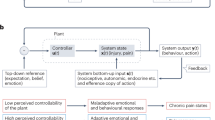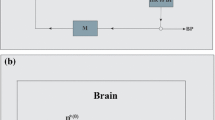Abstract
Injury whether caused by a road traffic accident, surgery or an infection presents a major challenge to the body’s homeostatic mechanisms. Indeed it can be argued that much of the acute general response to injury (shock) reflects the pattern of homoeostatic reflex responses to the local effects of injury.
Access this chapter
Tax calculation will be finalised at checkout
Purchases are for personal use only
Preview
Unable to display preview. Download preview PDF.
Similar content being viewed by others
References
Alam M, Smirk EH (1938) Observation in man upon a pulse accelerating reflex from the voluntary muscles of the legs. J Physiol 92: 167–177
Crile GW (1894) An Experimental Research into Surgical Shock. Lippincott Philadelphia
Dible JH (1970) Napoleon’s Surgeon. Heinemann, London
Eckberg DL (1980) Parasympathetic cardiocascular control in human diseases: a critical review of methods and results. Am J Physiol 239: H581–593
Frayn KN (1986) Hormonal control of metabolism in trauma and sepsis. Clin Endocrinol (in press)
Frayn KN, Little RA, Maycock PF, Stoner HB (1985) The relationship of plasma catecholamines to acute metabolic and hormonal responses to injury in man. Circ Shock 16: 229240
Grant RT, Reeve EB (1951) Observations on the General Effects of Injury in Man. Medical Research Council. Special Report Series 277, London
Hilton SM, Redfern WS (1983) Exploration of the brain stem defence areas with a synaptic excitant in the rat. J Physiol 345: 134 P
Little RA (1974) The compensation of post-traumatic oedema in the rabbit at different ages. J Physiol 238: 207–221
Little RA, Randall PE, Redfern WS, Stoner HB, Marshall HW (1984) Components of injury (haemorrhage and tissue ischaemia) affecting cardiovascular reflexes in man and rat. Quart J Exp Physiol 69: 753–762
Little RA, Redfern WS (1981) A method for studying baroreflex bradycardia in the unanesthetized rat. Br J Pharmacol 79: 308–309 P
Little RA, Stoner HB (1983) Effect of injury on the reflex control of pulse rate in man. Circ Shock 10: 161–171
Little RA, Stoner HB (1984) Effect of tissue injury on the changes in the blood pressure-heart rate reflex produced by haemorrhage in the rat. Arch Emerg Med 1: 182–183
Overman RR, Wang SC (1947) The contributory role of the afferent nervous factor in experimental shock: sublethal haemorrhage and sciatic nerve stimulation Am J Physiol 148: 289–295
Redfern WS, Little RA, Stoner HB, Marshall HW (1984) Effect of limb ischaemia on blood pressure and the blood pressure-heart rate reflex in the rat. Quart J Exp Physiol 69: 763779
Secher NH, Bie P (1985) Bradycardia during reversible haemorrhagic shock–a forgotten observation? Clin Physiol 5: 315–323
Thoren P (1979) Role of cardiac vagal C-fibres in cardiovascular control. Rev Physiol Biochem Pharmacol 86: 1–94
Tibbs DJ (1956) Blood volumes in gastroduodenal haemorrhage. Lancet 11: 266–274
Editor information
Editors and Affiliations
Rights and permissions
Copyright information
© 1986 Springer-Verlag Berlin Heidelberg
About this paper
Cite this paper
Little, R.A. (1986). Homeostatic Reflexes After Injury. In: Vincent, J.L. (eds) 6th International Symposium on Intensive Care and Emergency Medicine. Update in Intensive Care and Emergency Medicine, vol 1. Springer, Berlin, Heidelberg. https://doi.org/10.1007/978-3-642-82801-0_64
Download citation
DOI: https://doi.org/10.1007/978-3-642-82801-0_64
Publisher Name: Springer, Berlin, Heidelberg
Print ISBN: 978-3-540-16508-8
Online ISBN: 978-3-642-82801-0
eBook Packages: Springer Book Archive




